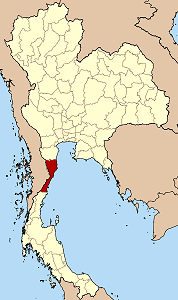Prachuap Khiri Khan Province
|
|
| Statistics | |
|---|---|
| Capital: | Prachuap Khiri Khan |
| Area: | 6,367.6 km² Ranked 33rd |
| Inhabitants: | 449.467 (2000) Ranked 56th |
| Pop. density: | 71 inh./km² Ranked 63rd |
| ISO 3166-2: | TH-77 |
| Map | |

| |
Prachuap Khiri Khan (Thai ประจวบคีรีขันธ์) is one of the central provinces (changwat) of Thailand. Neighboring provinces are Phetchaburi in the north and Chumphon in the south. To the west it borders Myanmar.
| Contents |
Geography
The district is located on the Kra Isthmus, the narrow landbridge connecting the Malay Peninsula with mainland Asia. The province contains the narrowest part of Thailand - directly south of the capital it is just 13 kilometers from the coast of the Gulf of Thailand to the border with Myanmar. The narrowest point of the Isthmus is however further south in the province Chumphon.
The long coast to the Gulf of Thailand has many sandy beaches, the most famous one being at Hua Hin, which has been a popular resort since King Prajadhipok (Rama VII) built a summer palace there. From the coast the land quickly rises into the mountain chain which forms the border to Myanmar, the highest elevation in the province being the 1494-meter-high Khao Luang. Due to this narrow watershed the rivers in the province are all small, the only bigger one is the Pranburi River in the north of the province.
The Khao Sam Roi Yot National Park was established in 1966 to protect Thailand's largest freshwater marshes, but also contains some mangrove woods and mudflats. Sadly most of the marshes were converted into shrimp farms, despite being in a national park.
History
The city of Prachuap Khiri Khan was reconstructed in 1845, after it was abandoned during the fall of the Ayutthaya kingdom in 1767.
In 1868 King Mongkut invited several guests to watch the solar eclipse on September 18. Being fond of science he predicted the event by himself, but the chosen observation point was the marshes near Sam Roi Yot where he contracted malaria, of which he died two weeks later.
During World War II Japanese troops occupied Thailand. On December 8, 1941 they first landed near the city of Prachuap Khiri Khan. After one day of battle the Thai troops resigned and had to allow Japan to use Thailand as a base for their war operations.
Symbols
| Missing image Seal_Prachuap_Khiri_Khan.png Seal of the province | The provincial seal show the Kuha Karuhas pavilion, which was built when King Chulalongkorn (Rama V) visited the Praya Nakorn Cave (King Amphoe Sam Roi Yot). Depicted behind the pavilion is the island of Ko Lak in Prachuap bay, the historic center of administration.
The provincial tree as well as the provincial flower is the rayan or manilkara (Manilkara hexandra). |
Administrative divisions
Amphoe_Prachuap_Khiri_Khan.png
Map of Amphoe
The province is subdivided into 7 districts (Amphoe) and one minor districts (King Amphoe). The districts are further subdivided into 48 communes (tambon) and 388 villages.
| Amphoe | King Amphoe | |
|---|---|---|
|
|
|
External links
- Province page from the Tourist Authority of Thailand (http://www.tourismthailand.org/province/province.php?id=68)
- Golden Jubilee Network province guide (http://kanchanapisek.or.th/cgi-bin/kp8/oncc/province.cgi?prov=c12)
fr:Province de Prachuap Khiri Khan nl:Changwat Prachuap Khiri Khan ja:プラチュワップキーリーカン県 th:จังหวัดประจวบคีรีขันธ์

